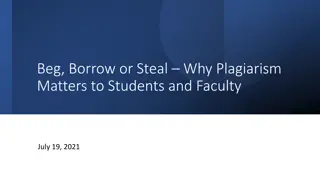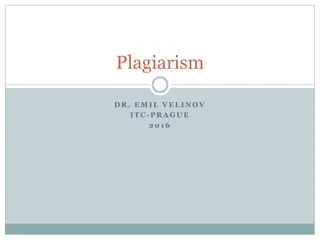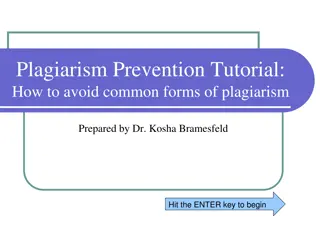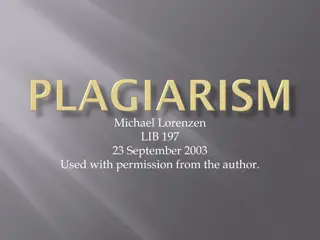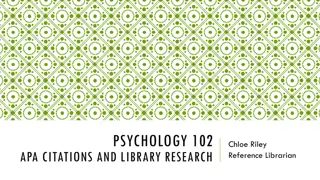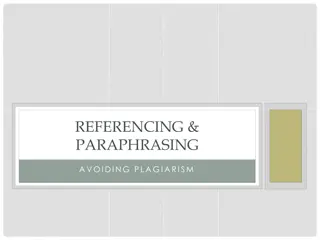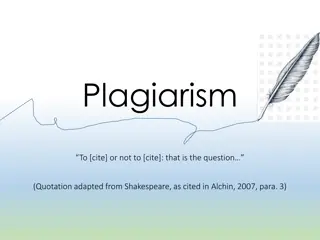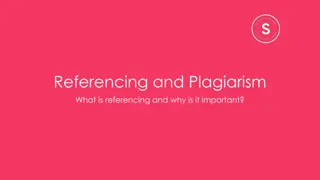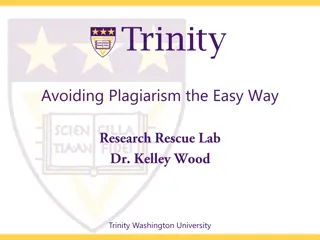PLAGIARISM AND DATA
Plagiarism is the act of literary theft, stealing someone else's words or ideas without crediting the source. It involves copying passages from another work without proper citation. Data falsification includes fabrication and manipulating research materials. The consequences of plagiarism and research misconduct are severe, leading to loss of credibility and legal implications.
Download Presentation

Please find below an Image/Link to download the presentation.
The content on the website is provided AS IS for your information and personal use only. It may not be sold, licensed, or shared on other websites without obtaining consent from the author.If you encounter any issues during the download, it is possible that the publisher has removed the file from their server.
You are allowed to download the files provided on this website for personal or commercial use, subject to the condition that they are used lawfully. All files are the property of their respective owners.
The content on the website is provided AS IS for your information and personal use only. It may not be sold, licensed, or shared on other websites without obtaining consent from the author.
E N D
Presentation Transcript
PLAGIARISM AND DATA FALSIFICATION IN THE LITERATURE
What is Plagiarism? Plagiarism is the act of plagiarizing , which means to appropriate (ideas, passages, etc) from another work or author . (British Dictionary) Plagiarism involves literary theft, stealing (by copying) the words or ideas of someone else and passing them off as one s own without crediting the source. (Park 2003, 475)
UMSL Definition in the Student Conduct Code The term plagiarism includes, but is not limited to: (i) use by paraphrase or direct quotation of the published or unpublished work of another person without fully and properly crediting the author with footnotes, citations or bibliographical reference; (ii) unacknowledged use of materials prepared by another person or agency engaged in the selling of term papers or other academic materials; or (iii) unacknowledged use of original work/material that has been produced through collaboration with others without release in writing from collaborators.
Definition of Research Misconduct US Department of Health and Human Services Research misconduct means fabrication, falsification, or plagiarism in proposing, performing, or reviewing research, or in reporting research results. (a) Fabrication is making up data or results and recording or reporting them. (b) Falsification is manipulating research materials, equipment, or processes, or changing or omitting data or results such that the research is not accurately represented in the research record. (c) Plagiarism is the appropriation of another person's ideas, processes, results, or words without giving appropriate credit. (d) Research misconduct does not include honest error or differences of opinion. http://ori.hhs.gov/definition-misconduct
Breslows Dinosaur Case Breslow used to be president of the American Chemical Society. Full professor at an Ivy League university (Columbia). Member of the US National Academy of Sciences.
The paper New scientific research raises the possibility that advanced versions of T. rex and other dinosaurs monstrous creatures with the intelligence and cunning of humans may be the life forms that evolved on other planets in the universe. We would be better off not meeting them, concludes the study, which appears in the Journal of the American Chemical Society. Breslow describes evidence supporting the idea that the unusual amino acids carried to a lifeless Earth by meteorites about 4 billion years ago set the pattern for normal amino acids with the L-geometry, the kind in terrestial proteins, and how those could lead to D-sugars of the kind in DNA. http://blog.chembark.com/2012/04/12/breslow-and-dinosaurs-in-jacs-oh-my/
Breslow copied and pasted from his own earlier papers on the topic http://skepchick.org/2012/04/is-it-still-plagiarism-if-you-copy-yourself/
Two more pages plagiarism in red. http://skepchick.org/2012/04/is-it-still-plagiarism-if-you-copy-yourself/
July 1993 (3): "Misconduct cases include two chemists: Leo A. Paquette, professor of chemistry at Ohio State University; and James H. Freisheim, former chairman of the Department of Biochemistry and Molecular Biology at the Medical College of Ohio . . . . plagiarized grant applications the scientists had reviewed"
The BENG SEZEN Case http://blog.chembark.com/2011/07/08/the-sezen-files-%E2%80%93-part-ii-unraveling-the-fabrication/ http://blog.chembark.com/2011/07/08/the-sezen-files-%E2%80%93-part-ii-unraveling-the-fabrication/
The BENG SEZEN Case In July of 2005, most people would have viewed Bengu Sezen as a promising young star of organic chemistry. She had finished her Ph.D. at Columbia in less than five years, published several high-impact papers in the hot area of C H activation, and secured a postdoctoral position at Stanford in the laboratory of esteemed chemist Chaitan Khosla. But Bengu Sezen s Ph.D. defense was not just the latest mountain conquered in her ostensibly stellar career it was the beginning of her career s end. Sezen began grad school in August of 2000, and by the time she was done in 2005, she had produced six first-author papers. It had long been known within the Sames Lab and in the world of C H activation research that the chemistry developed by Sezen and Sames had issues. Chemists were having trouble reproducing the results as early as the summer of 2002. Sames had been contacted by several groups outside Columbia who could not get the reactions to work, and inside the Sames Lab, many students were having problems launching spin-off projects. In response to these troubles, Sames directed Sezen to provide guidance to those who made outside inquiries, and she assisted her labmates in running their reactions. Even with Sezen s assistance, the results were inconsistent. The most charitable assessment of the body of work was that the reactions were finicky or sensitive (to the conditions).
The gravity of the situation peaked in July of 2005, when Sezen defended her thesis and was going to leave campus for good. After her departure, the other students in the Sames Lab would be forced to fend for themselves; Sezen would no longer be present to provide assistance. To say that the stakes for the remaining researchers were high is an understatement. Sames had previously dismissed students from his lab, in part, for their inability to reproduce Sezen s published, peer- reviewed work. It was at this time that one astute labmate noticed that the reactions only produced an appreciable quantity of product when Sezen had access to the laboratory in private. Operating on the assumption that she might have been tampering with the reactions, the labmate set up dual copies of a run-of-the-mill example of Sezen s chemistry, the conversion of imidazole to phenylimidazole.
At least, that is what the labmate told Sezen. What he actually did was to set up one reaction with imidazole as the starting material and the other with N-methylimidazole. The next day, when the reactions were worked up, the product expected of (plain) imidazole was present in both flasks. The methyl label had vanished from the other substrate a result that could only be explained by sabotage. The results of the trap were relayed to Sames, who initiated a more thorough (but informal) in-house investigation. The lab poured through her notebooks (aptly named BS-I through BS-XI ) and her electronic data. It was soon discovered that these documents contained very little information that made sense. The reactions she appeared to run were reported in *very* scant detail, which was particularly odd for reactions that were supposedly as finicky to the conditions as hers. The last date written in her notebook was 9 June 2003.
During the informal investigation by Sames, someone in the survey team stumbled across spectra belonging to Sezen that had been altered with White-Out. The altered spectra had also appeared in one of Sezen s publications. This was the springboard for a more thorough investigation of her NMR data. It was soon discovered that Sezen never even had her own NMR account at Columbia. She also had not placed orders for all of the combustion/elemental analyses she reported. She did collect some NMR spectra: she signed the log book of various instruments and appeared to use the NMR accounts of departed researchers.
In the analysis of the accounts that Sezen is believed to have used, several series of files were discovered that essentially showed (step- by-step) how she fabricated NMR spectra for some of her compounds. The process went as follows for her 1H NMR spectra: she started with a peak corresponding to methylene chloride, then to insert new peaks in her spectrum, she shifted and scaled the methylene chloride peak and added it to the parent spectrum using the instrument s proprietary software. Aside from the intermediate files that were found that essentially show the step-by- step process of the fabrications, a second tell-tale sign was that all of the signals had satellite peaks that corresponded to the JCH coupling constant specific to methylene chloride of 177 Hz. She appears to have done the same with her 31P NMR spectra by cutting-and-pasting a peak corresponding to triphenylphosphine.
In the analysis of the accounts that Sezen is believed to have used, several series of files were discovered that essentially showed (step-by-step) how she fabricated NMR spectra for some of her compounds. The process went as follows for her 1H NMR spectra: she started with a peak corresponding to methylene chloride, then to insert new peaks in her spectrum, she shifted and scaled the methylene chloride peak and added it to the parent spectrum using the instrument s proprietary software. Aside from the intermediate files that were found that essentially show the step-by-step process of the fabrications, a second tell-tale sign was that all of the signals had satellite peaks that corresponded to the JCH coupling constant specific to methylene chloride of 177 Hz. She appears to have done the same with her 31P NMR spectra by cutting-and-pasting a peak corresponding to triphenylphosphine.
Sames provided a draft report of his findings to Columbia in August 2005, and a formal complaint was launched against Sezen in a memorandum on 7 November 2005. In the meantime, Sames contacted Chaitan Khosla and her postdoctoral appointment was put on hold. The preliminary inquiry was finished on 16 February 2006, when a final report was submitted to Columbia s Dean of the Graduate School of Arts and Sciences. Sames retracted his first set of papers from JACS on 1 March 2006. Sezen s defense was predicated on a strategy of long periods in duck-and- cover mode (avoiding the investigation), interspersed with short bursts of attacks. In the period following her departure from Columbia until the scandal broke publically, she generally avoided answering e-mails and Columbia did not have a physical address where it could send her documents. Sezen appeared to hand-deliver a written letter to Columbia in January.
When the retractions were posted in March 2005, Sezen came out of hiding to make public statements to the media in emphatic defense of her work. She also said she first learned of the retractions after they had been published a claim that may have some degree of veracity as JACS/Sames altered the wording of the retractions later that month. Following the public blow-up of the story, Sezen started acknowledging (to Columbia) the fact that an investigation existed. She acknowledged receipt of the Inquiry Report on 27 March 2006. On 19 May 2006, she provided comments on the report and (astonishingly) launched a counter-claim that alleged her accusers fraudulently claimed they could not reproduce her work in a campaign to discredit her and steal her results. After ducking attempts by Columbia to get her to submit to an interview in the summer of 2006, that August, she contacted Science, Nature, and the New York Timeswith complaints about Columbia s handling of the investigation. She also spammed these complaints to scores of professors at the nation s top chemistry departments. ChemBark saw but never reported one such e-mail sent to a Harvard professor in 2006.
Apparently eager to get to the bottom of the story and put the investigation to rest, Columbia went out of its way to provide Sezen with materials to review regarding the investigation. It even retained the services of a law firm in Europe to provide a place for her to receive and review thousands of pages of documents. Eventually, after several on-again/off-again cycles of interacting with the investigation committee she claimed visa issues prevented her from returning to New York and she repeatedly called off telephone interviews Sezen submitted to a telephone interview on 6 October 2006. It is unclear when, exactly, Sezen mounted the defenses listed below, but her story included: She denied that she had enrolled in a (second) Ph.D. program at the University of Heidelberg, then later recanted this denial. She denied ever using the NMR accounts of departed researchers at Columbia. She claimed her NMR account had the user name bengu . The NMR facility manager reported no such account ever existed.
Regarding the missing data for her experiments, she claimed to maintain a supplementary set of notebooks with the details of her procedures. Similarly, she had supplementary binders of spectra that were not in Columbia s possession. She claimed that a company named Duha Chemisches Katalyse-Labor (a.k.a. Duha ) successfully reproduced her work. An official at the company named Ralf Decter sent Columbia an electronic message to verify Sezen s claim. The problem the IP address of the computer that sent the message traced to the University of Heidelberg (where Sezen was studying in 2006). An official at Duha (perhaps also Decter the name was redacted) also sent a written letter to Columbia. Columbia contacted the business located at the address on the Duha letterhead, and the person who responded said that he neither knew of Ralf Decter nor a company named Duha . These entities were adjudged by the investigation committee to be fictitious.
Similarly, in what was perhaps an attempt to scare Columbia, Sezen claimed in January 2006 she had retained the services of a lawyer named M. Atkas. M. Atkas wrote a memo to Columbia in February 2006. Columbia could not contact Mr. Atkas and a search revealed no lawyer by that name (or his business, Barrington Law Firm ) to exist. Sezen claimed that purchase requisitions did not exist for many of her combustion analyses because she obtained them in free trials. Columbia could find no vendors who offered free trials for elemental analyses. Unsurprisingly, the full investigation by Columbia found Sezen s defenses not to be credible. Its final report enumerated many specific instances of plagiarism and fabrication (mainly spectra and elemental analyses) in great detail. This report formed the basis of a similar report tied to the investigation of Sezen by the Office of Research Integrity. In November 2010, the ORI cited 21 specific instances of misconduct in suspending Sezen from receiving federal funding for five years. While Columbia stated last year it was moving to revoke her degree, it is unclear whether this has happened.
Data Falsification: BENG SEZEN Case CEN News August 8, 2011
Consequences of Sezens Case The Committee finds that Dr. Sezen s actions had a significant impact on other researchers both within and outside Columbia University. As discussed above, researchers made substantial and futile efforts, with consequent loss of time and expenditure of resources, to reproduce and extend Dr. Sezen s research results. Two graduate students, were asked by group at the beginning of the third year of their graduate study and one graduate student, decided to leave the second-year qualifying examination. Each of these students spent much time unsuccessfully trying to reproduce and extend Dr. Sezen s work. and have differing recollections as to why the students were either asked to leave or voluntarily left his group. The students believe that their lack of success with Dr. Sezen s chemistry was a major factor, while that other factors were determinative. The Committee is not charged to resolve these differing recollections and opinions, but it believes that the wasted time and effort, coupled with the onus of not being able to reproduce the work, had severe negative impacts on the graduate careers of these students. http://blog.chembark.com/2011/07/15/the-sezen-files-part-iii-and-what-of-sames/ to leave his after passing the says
Consequences from the Department of Health and Human Services
Retracted Paper http://blog.chembark.com/2011/07/15/the-sezen-files-part-iii-and-what-of-sames
Dorta Case: Paper published after corrections start
Authors Response to ChemBark Dear Professor Bracker There is probably a mistake as I know that the 1st supporting information with some spectra were wrong and I asked an other student to reproduce the experiments and sent back an other SI with the right spectra, may be the 1st SI was not changed by the right one. Right now, I am abroad and can not check but I am going to check with the Organic Letters editorial office and I will tell them to contact you Sincerely yours Janine Cossy http://blog.chembark.com/2013/08/19/some-very-peculiar-nmr-spectra-in-organic-letters / https://www.chemistryworld.com/news/with-great-blogging-power-comes-great- responsibility/6528.article
Data Falsification: BENG SEZEN Case CEN News August 8, 2011 Dec. 2000 Sezen joins the lab of chemistry professor Dalibor Sames as a graduate student. Oct. 2002 Sezen publishes in JACS (DO!: lO.1021/ja027891q) with her first fraudulent NMR spectrum. 2002 The first concerns about the reproducibility of Sezen s work are raised. July 1,2005 Sezen defends her chemistry Ph.D. dissertation. July 2005 Sames lab member designs experimental sting operation that provides the first direct evidence of possible fraud by Sezen. Oct. 19, 2005 Sezen is awarded a Ph.D. degree in chemistry with distinction. Nov. 7, 2005 Columbia memorandum cites fabricated data by Sezen in a 2004 JACS paper. Feb. 16, 2006 An Inquiry Committee reports clear evidence of Sezen s misconduct. March June 2006 Sames retracts six papers coauthored with Sezen that appeared in JACS and Organic Letters. Aug. 2006 to Feb. 2007 A full investigation of Sezen is undertaken by Columbia. Nov. 2010 The federal Office of Research Integrity levels 21 findings of scientific misconduct March 2011 Columbia retracts Sezen s Ph.D. degree in chemistry.
Elemental Analysis Determined by Combustion The composition of a compound is often expressed in terms of the weight percent of each element in the compound. For example, ethanol has the formula C2H6O. One mole of ethanol has a mass of 46.07 g. 52.14 % C + 13.13 % H + 34.73 % O = 100.00 % Combustion elemental analytical values for carbon and hydrogen (and nitrogen, if present) agreeing with calculated values within 0.4%.

 undefined
undefined







